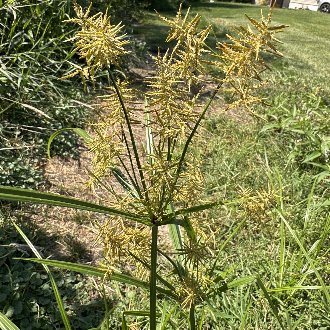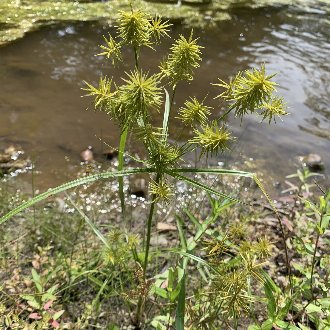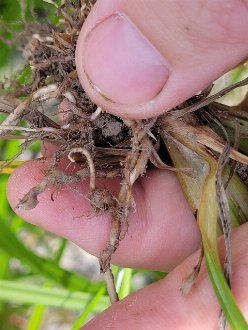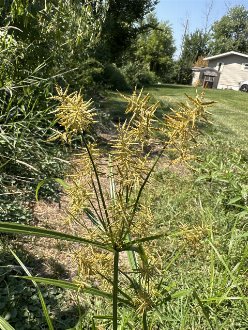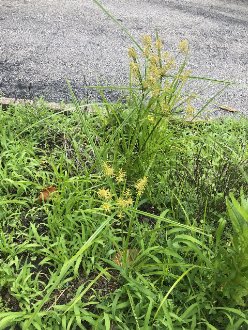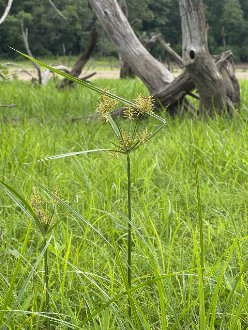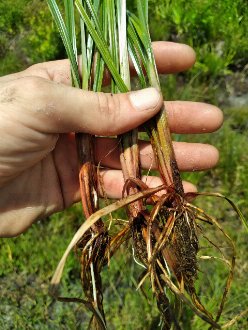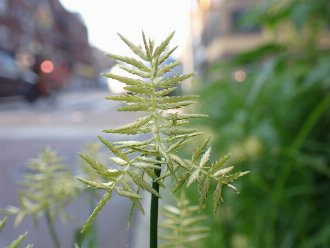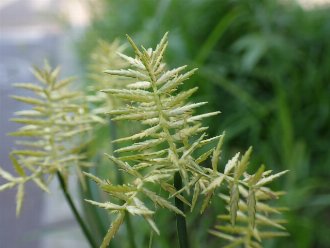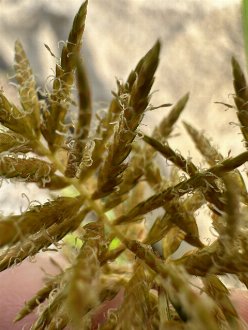Yellow Nutsedge (Cyperus esculentus L.)
Also known as chufa, tiger nut, earth almond, atadwe, pfende, water grass.
Some authorities recognize different sub-taxa of this species, but there is little agreement as to how many to recognize. POWO does not recognize any, and instead treats this as a single species native to Africa, Europe, North and South America, and Central through South Asia. BONAP recognizes three varieties, and reports the most widespread, var. leptostachyus as native; FSUS also considers var. macrostachys native, and Calflora recognizes var. heermannii as native to California.
↑Summary
A native, weedy, perennial flatsedge of moist, sunny areas, spreading by rhizomes and edible tubers.
↑Range - Expand
| Legend | Color |
| Native | |
| Native or Not Present |
This tentative map is based on our own research. It may have limited data on Canada and/or Mexico, and there is some subjectivity in our assignment of plants as introduced vs. expanded. Read more in this blog post.
Although this plant occurs somewhere in each of these regions, it may only occur in a small part of some or all of them.
Different sources give conflicting reports of whether this species is native to North America. Our research suggests that it colonized North America recently in geologic time, but long before European colonization of the Americas and without any help from humans, so we consider it native. Ecologically, it functions like a native plant, with many insects that eat it.
↑Similar Plants
↑Habitat
Yellow nutsedge grows in moist, sunny conditions, in loose-textured soil, on sites that have experienced disturbance in late spring to summer. It is common in both natural and anthropogenic habitats. Natural habitats include wet depressions in prairies and open woodlands, sedge meadows, and edges of ponds and wetlands. Anthropogenic habitats include moist, poorly-drained spots in lawns, gardens, cropland, and waste areas, irrigated lawns and gardens, mulch beds in landscaping, and roadside ditches. It is often one of the most common flatsedges (Cyperus sp.) in much of its range, and is the most likely to be found in lawns.
It grows in moisture conditions ranging from wet/waterlogged to mesic. It prefers looser soil textures including loam, silt, and sand, but it can also occur where a layer of clay underneath looser soil impedes drainage. Moisture requirements are highest on sandy soils, and in sandy soils this species is typically limited to wetlands.
Yellow nutsedge is intolerant of shade from trees or taller vegetation, and as such is restricted to sites experiencing regular disturbance, ideally happening in early summer just before its vegetation emerges. It can survive repeated top-kill better than most plants, including frequent mowing. Humans have greatly increased the habitat for this species through widespread mowing and irrigation of lawns and gardens, irrigated cropland, and in recent years, through heavy use of mulch beds with a lot of open space between plants. The introduction of wild boars into the southeastern US has also increased habitat for this species, as their digging for tubers tends to create soil disturbance that kills other vegetation and creates conditions for this species to thrive.
↑Life Cycle
This species is a perennial that forms both rhizomes and tubers. Reproduction is primarily vegetative and spread can occur both from new tubers growing from rhizomes, and from tubers, sometimes with connected rhizomes, being moved from one site to another. Such transport can be facilitated by humans, other animals, or water, which can carry floating tubers long distances, including across the Atlantic ocean. Reproduction from seed is less common but does happen.
Seeds germinate in late spring, when seeds are near the soil surface, usually within the top inch (2.5cm) or less, and when the soil has been consistently moist or wet.
The foliage, whether of seedlings or established plants, emerges rather late into the growing season, typically only when the danger of frost is past and temperatures are consistently warmer. Plants rely exclusively on C4 metabolism, which reduces water demands even in the moist conditions it is found in.
Plants growing in nitrogen-rich conditions grow more aboveground parts but have reduced underground growth, whereas the opposite is true in low-nitrogen conditions. This plant is highly competitive at absorbing nitrogen and can often absorb it more quickly than other plants.
Flowering occurs from late summer into early fall, and flowers are wind-pollinated. Plants are self-incompatible, requiring cross-pollination to produce viable seed.
Seeds have a low germination rate and can remain viable for years if buried deeper in the soil. Seeds near the surface typically germinate or die within about 3 years.
Tubers are frost-sensitive, with cold killing most of the shallower tubers in the northernmost portions of its range. Plants can emerge from deeper tubers than from seeds, with it being common for new plants to emerge from depths of 4-8 inches (10-20cm) and some plants being recorded emerging from as deep as 32 inches (81cm.) However, most tubers form within the top 6 inches (15cm) of soil.
↑Faunal Associations
The foliage is edible to mammalian herbivores, but is not usually a preferred food source because it is both tough and thin, and emerges during a relatively brief time period when other foliage is abundant. Cattle browse it in pastures, but do not prefer it. Pigs, wild boars, and squirrels, and likely other small mammals, eat the tubers.
The foliage, spikelets, and tubers are all consumed by the Canada Goose. Wild Turkey and dabbling ducks, including Northern Pintail, Green-Winged Teal, Blue-Winged Teal, and Mallard, also eat the spikelets and tubers.
Several lepidoptera eat this species in their larval form. The larvae of the dun skipper (Euphyes vestris) eat this and other sedges. The lesser cornstalk borer (Elasmopalpus lignosellus), a generalist that is a minor pest of many cultivated crops, bores into the stem of this and many other plants. The javelin moth (Bactra verutana) feeds on this plant as well as some Scirpus and Juncus species. One species, the yellow nutsedge moth (Diploschizia impigritella), specializes on this species, boring into the stems and leaf sheaths.
Several billbugs (a type of beetle), common in managed turfgrass, feed on this plant, including the southern corn billbug (Sphenophorus callosus), destructive billbug (Sphenophorus destructor), and hunting billbug (Sphenophorus venatus); S. venatus prefers this as its host plant.
Several true bugs (hemiptera) also eat this species. The burrowing bug Cyrtomenus ciliatus feeds on this plant. The bermuda grass mealybug (Chorizococcus rostellum), mostly found in the southeast, and which primarily eats bermuda grass, also feeds on the roots of yellow nutsedge. The generalist solanum mealybug (Phenacoccus solani), mostly found in the southwestern US, feeds on lower leaves and roots.
The numerous insects and larger animals that eat the belowground portions of this plant are a major factor in how this plant can improve soil textures. Not only does this species invest most of its energy in below-ground growth, but by growing nutritious tubers fairly deep in the soil, it incentivizes animals to dig in the soil, helping to mix organic matter into lower soil layers, which can improve soil texture and aeration especially when this plant is growing on clay and/or compacted soils such as often occur under shallow-rooted turfgrass.
↑Control
This species is frequently, but often unnecessarily viewed as a weed. It is native to North America and in most cases it does not need to be controlled. Attempting to remove it is extraordinarily difficult, and can be resource-intensive and do more harm than good. This is particularly the case in lawns, where nutsedge improves soil texture relative to turfgrass monocultures, and where it supports the food web much more than most non-native turfgrasses.
The resources unnecessarily invested in trying to control this plant could be redirected towards controlling any number of other plants that are much more harmful both to ecosystems and to commercial agriculture.
Occasionally, yellow nutsedge can become a problematic weed in cropland, usually in low-growing, warm-season crops, on sites with the moist, poorly-drained conditions it prefers. These wet conditions are often produced by over-irrigation. In these circumstances it can sometimes outcompete crops for nitrogen. Crops most harmed by yellow nutsedge in this manner include sugar beets, potatoes, leeks, onions, and brussel sprouts.
Many crops, however, are competitive against yellow nutsedge, including soybeans and corn, which grow tall enough to shade it out, and have superior drought-tolerance. Beans and other legumes fix their own nitrogen, making them competitive against nutsedge's high nitrogen-drawing capability. The timing of crop planting as early as is frost-safe will usually ensure that crops are sufficiently large by the time nutsedge emerges, so that it cannot compete. Improving drainage and refraining from over-irrigation, especially when growing more drought-tolerant crops, can also eliminate this plant by creating drier conditions where it can no longer thrive.
Yellow nutsedge does not need to be controlled in pastures as it is edible to cattle and other browsing livestock and poses no risk to them. It can be beneficial when growing in pig pens, as pigs enjoy eating the tubers.
↑Uses
Yellow nutsedge is widely cultivated as a food plant, in West Africa, North Africa, Western Europe, and China; in this usage it is often called chufa. In Spain, it is made into a drink called horchata de chufa; the main area of production is in Alboraya, near Valencia. In West and North Africa the tubers are eaten primarily as a snack, and also sometimes made into a flour or used in a drink. The tubers also have a high oil content with a healthy fat profile, and are sometime used as a source of oil, marketed as tiger nut oil. Tiger nut oil consists mainly of monounsaturated fact like olive oil or avocados, and also has a high vitamin E content. Strains have been cultivated to produce larger tubers, but tuber size is also heavily influenced by soil texture, forming larger tubers on looser soils.
In North America, in area where it is not considered a noxious weed, yellow nutsedge is sometimes planted on a large scale in order to increase populations of Wild Turkey.
This species can also be planted intentionally in cropland in order to improve soil texture. The plant's rhizomes and tuber growth both directly breaks up soil and adds organic matter to the soil, and creates further indirect benefits by encouraging animals to burrow in soil, seeking the nutritious tubers, which improves mixing and further distributes organic matter in the soil while also improving aeration. This use has primarily been carried out in northeast China, although it has also been used for this purpose less commonly, but successfully, in the rocky soils of New England.
↑Related Plants
Numerous other Cyperus species are also found in North America, mostly native and a few introduced; many of them overlap with this one in range. Among these, this species is probably closest-related to papyrus (Cyperus papyrus), which is introduced, smooth flatsedge (Cyperus laevigatus), which is native to the West Coast, manyspike flatsedge (Cyperus polystachyos) and jointed flatsedge (Cyperus articulatus), which are native to the southeast, and purple nutsedge (Cyperus rotundus), which is introduced in North America and widely-considered invasive in the southern portions of the continent; purple nutsedge is not as cold-hardy and does not range as far north.
↑Notes
The native status of this species is sometimes confusing or controversial. This 2015 molecular analysis and the other work it cites, points to the hypothesis that this species originated in Africa and colonized the Americas recently in geologic time, but before Europeans. The article notes that the plant was present in Americas prior to European colonization, and that the more cold-tolerant North American variety was introduced to Europe, not vice-versa as previously thought. Furthermore there is evidence that this species has traveled repeatedly in both directions across the tropical Atlantic, by floating on water. We note that even authors that recognize different subtaxa of this species still typically note them as varieties, not subspecies, reflecting that there is extensive gene flow between populations, and, according to that research, probably even was gene flow prior to European colonization of the Americas.
Yellow nutsedge is a prime example of how cultural differences can create major disparities in how people in different places perceive and interact with the same plant. In some parts of the world, this plant is seen as a crucial food plant, and in others, as a way to support wildlife and/or improve soil texture. In North America, yellow nutsedge is a widely hated plant, but this hatred stems not from any ecological concern (it is native and good at supporting wildlife and improving soil texture, and does not pose any direct threats to wild ecosystems, only through interaction with other invasive species), and only minimally from its role as an agricultural weed (it is a weed, but only in certain types of cropland, in certain parts of the country, and usually only due to human alteration of the environment such as irrigation) but rather the hatred of this plant stems primarily from the fact that it invades monoculture lawns and thus poses a threat to lawn culture.
In a monoculture lawn, yellow nutsedge angers some lawn enthusiasts because it grows taller and faster than most turfgrass, and is a different (more yellowish) color than the turf, so that only a few days after mowing, its blades stick up prominently above the rest of the lawn. Some people complain that these blades can feel sharp if walking barefoot over the lawn, but an overwhelming majority of people complaining about this plant never walk barefoot on their lawns and are only complaining about this plant for purely aesthetic reasons.
This species can also be very difficult to eliminate from lawns. As a monocot, it is unharmed by selective herbicides that target broadleaf plants. It survives mowing, and can spread aggressively even if mowed regularly.
Our recommendation, in North America where this species is native, is to embrace and appreciate this plant's presence in lawns, adjust our aesthetics to see it as beautiful, and also to follow its lead and abolish monoculture lawns entirely, allowing many different plant species, ideally native ones, to grow in lawns.
↑Links & External Resources
• Cyperus esculentus (Yellow Nut Sedge) | Illinois Wildflowers (About This Site)
• Cyperus esculentus (yellow nutsedge) | USDA PLANTS Database (About This Site)
• Cyperus esculentus | Go Botany (About This Site)
• Cyperus esculentus | Biota of North America Project (BONAP) (About This Site)
• Cyperus esculentus | NatureServe Explorer (About This Site)
• Cyperus esculentus | Flora of North America (About This Site)
• Cyperus esculentus | Missouri Plants (About This Site)
• Yellow Nutsedge | Maryland Biodiversity Project (About This Site)
• Cyperus esculentus L. | Plants of the World Online (POWO) (About This Site)
• Cyperus esculentus L. var. leptostachyus Böckler (Yellow Nutsedge, Yellow Nutgrass, Wild Chufa, Earth-almond) | Digital Atlas of the Virginia Flora (About This Site)



